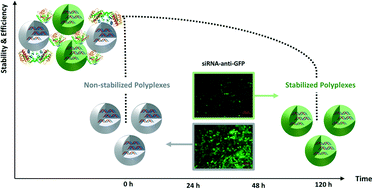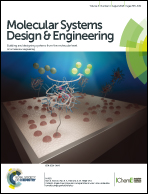Stable and efficient generation of poly(β-amino ester)s for RNAi delivery†
Abstract
Cationic polymers are promising delivery systems for RNAi due to their ease of manipulation, scale-up conditions and transfection efficiency. However, some properties, such as stability and targeting, remain challenging to overcome. In this report, different modifications in poly(β-amino ester) (pBAE) structures have been explored to overcome these limitations. Recent studies have demonstrated that hydrophobicity plays a key role in controlling electrostatic interactions of plasma proteins with nanoparticles. Results show that a slight increase in the polymer hydrophobicity increases its siRNA packaging capacity, stability, and transfection efficiency. Consequently, polyplexes prepared with these hydrophobic structures are functional after incubation times longer than 48 hours in serum-containing medium. In addition, newly designed polymers were end-modified using different oligopeptide moieties in order to confer cell-specificity, as previously reported. Therefore, it can be concluded that these newly optimized pBAE polymers present great potential as delivery vectors to specifically drive therapeutic RNA-based nucleic acids in a cell-specific manner under physiological conditions.

- This article is part of the themed collection: MSDE most-read Q1 2019


 Please wait while we load your content...
Please wait while we load your content...